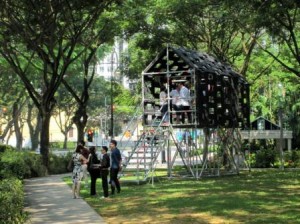Over the summer 2012, Professor Hayley Fowler, co-chaired a two-week workshop at the National Centre for Atmospheric Research, in Boulder, Colorado on ‘Uncertainty in climate change research: an integrated approach’. Taking decision making as a starting point, the workshop focussed on: methods that facilitate consistent treatment of uncertainties in different parts of the climate change problem; accounting for additional factors outside quantifiable ones that contribute to uncertainty in decision making; accounting for the effect of cognitive biases that prevent consistency from one discipline to the next, and the critical differences in the end-to-end academic process vs. reality (i.e. practical application vs. theoretical approaches). The workshop comprised of a number of presentations from academics and practitioners from the UK and US, including Claire Walsh from CESER, who presented the group’s work on long term changes and integrated assessment in London. Participants came from a wide variety of disciplines: statistics, climate modelling and analysis, climate impacts, decision making, policy, communication, and social science concerned with vulnerability and climate change. An important and valuable component of the workshop was the participants working on mini research projects in interdisciplinary groups. Selma De-Brito Guerreiro, a PhD student in the CESER group attended the workshop as a participant.
Monthly Archives: September 2012
Conference: Engineering Education for Sustainable Development
 6th International Conference on ENGINEERING EDUCATION FOR SUSTAINABLE DEVELOPMENT:EESD13
6th International Conference on ENGINEERING EDUCATION FOR SUSTAINABLE DEVELOPMENT:EESD13
Robinson and Pembroke Colleges,
University of Cambridge,
Cambridge, UK 22-25 September 2013
CONFERENCE THEME: Rethinking the Engineer This Conference will explore how engineers can be educated to apply new approaches and a wider set of choice criteria when formulating solutions to wicked and messy problems. How can Universities and life long learning help deliver a reconfiguration of an engineer’s professional outlook and responsibilities?
Abstracts should be submitted by 18th January
BHS National Meeting: Hydrological challenges and emerging solutions in urban areas
Hydrological challenges and emerging solutions in urban areas
Wednesday 26th September 2012, 1000-1630
Darwin Suite, Centre for Life, Newcastle upon Tyne
This meeting will bring together scientists, engineers, water managers, regulators, consultants and policy-makers to discuss these issues. Speakers include: David Balmforth, ICE; John Robinson, Newcastle City Council; Chris Kilsby, Newcastle University; Vedrana Kutija, Newcastle University; Lynne Jack, Heriot-Watt University; Brighid Ó Dochartaigh, British Geological Survey and Fayyaz Memon, Exeter University.
Register at: http://www.hydrology.org.uk/meetings_events.asp or contact claire.walsh@ncl.ac.uk
Stilt House: urban art installation project
STILT HOUSE is a Fine Art led interdisciplinary research project involving Art, Architecture and Civil Engineering.
The engagement of artists with complex issues such as climate change presents both opportunities, and inherent contradictions, relating to the symbolic, creative and material characteristics of art, and issues of public understanding of the representation of science and intervention and communication through an artistic viewpoint. Importantly, such artworks can place an emphasis on environmental issues experienced both materially and conceptually within local and global contexts. This provides the possibility to influence the public’s attitudes and behaviours in arenas beyond those of the traditional domains of scientists, engineers and city planners.
STILT HOUSE is a site-specific artwork consisting of two interconnected structures that are made from recycled plastic waste, exhibited as part of HubtoHub, Archifest 2011 in Singapore. Sited at Dhoby Ghaut Green the architectural installation offers, through it’s perforated black walls, an elevated and translucent perspective on the surrounding land and cityscape. By reinterpreting this traditional stilt housing typology, which was originally made from sustainable local materials and was ecologically adapted to the specific climate and landscape, STILT HOUSE encourages us to rethink our relationship with the environment we inhabit. It also confronts us with the debris of our consumer society in the unexpected form of an innovative building material that translates waste into new productive and aesthetic uses.
Website: http://www.hubtohub.sg/exhibition.html#team-DhobyGhautGreen
STILT HOUSE was created by Prof Wolfgang Weileder (Fine Art, Newcastle University), in collaboration with Prof Simon Guy (Manchester Architecture Research Institute) and CESER Researcher Dr Oliver Heidrich (Civil Engineering, Newcastle University).
Prof Simon Guy and CESER Researcher Dr Oliver Heidrich are currently writing a paper on the project addressing the following questions:
- Can urban art installations both represent and intervene in issues of climate change/sustainability through their selection of materials?
- Does the answer have anything useful to contribute towards discussions of sustainable cities?



